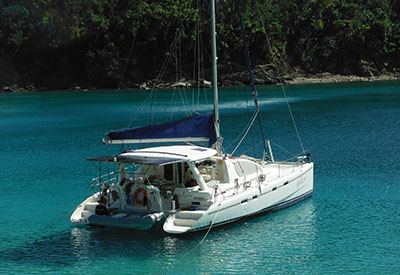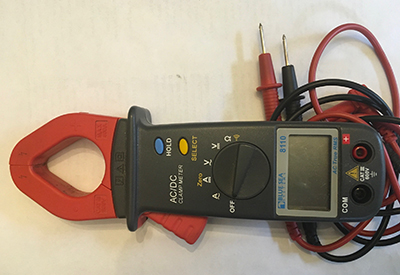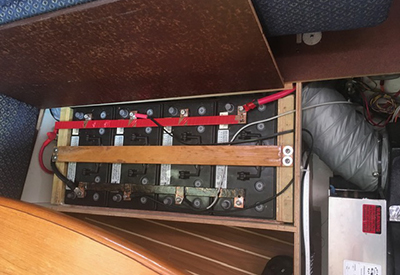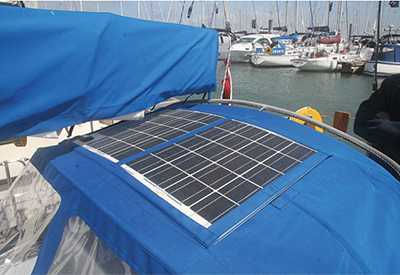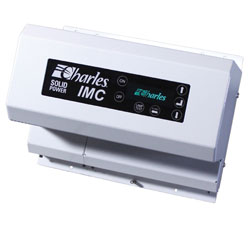New Technologies Improve on the Flooded Marine Battery
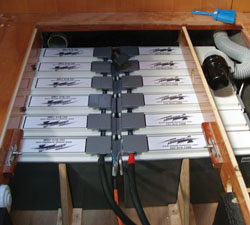
Batteries lie at the heart of most boats. We need them to start our engines, power our electronics, chill our food and sometimes cook our meals. We rely on them but often don’t give them much thought until they fail. Or outlive their normal lifespan of about five years and need to be replaced.
With major advances in new technologies reaching the marine marketplace, let’s take a look at alternatives to the traditional lead-acid battery.
Flooded Batteries
Liquid or “flooded” batteries have been in use for centuries and in common lead-acid batteries for at least the last hundred years. They are relatively inexpensive to make and their performance, though modest by the standards of today’s new battery technologies, is at least well known and predictable.
In marine applications, flooded batteries come in two basic constructions depending on their intended use: starting or house. For starting batteries we want maximum power for a short time, usually measured in “cold cranking amps.” These batteries have thinner lead plates but more of them and deliver the strong “bursts” of power needed for starting. But for house applications (lights, appliances, electronics) we need long life under load, the sort of performance that we get from deep-cycle batteries. These have thicker lead plates and will withstand deeper discharge and more use-and-charge “cycles.”
The advantage of flooded batteries is their low cost and predictability. Most boaters know what needs to be done to maintain them – most of us, after all, have used one for years in automobile starting applications.
Disadvantages include their weight and bulk, and the need for them to be kept upright to avoid toxic acid leaking. And their performance is only so-so compared to newer technologies. Most troubling is the amount of maintenance they require. Liquid levels need to be checked regularly and water added if necessary. Out-gassing is constant, unpleasant and can be corrosive to nearby electronic equipment. Heat is generated during recharge, and “boiling over” and fluid loss is a constant danger. Recharging is always slow.
Only a small amount of the total capacity of a flooded battery can be used before recharging is needed. At 50 percent discharge the battery is commonly considered “flat,” while many manufacturers recommend not going below 35 percent to maximize battery life. A fully charged battery might have 100 amp-hours at a full charge of 12.8 volts. But this would be considered fully discharged at only10.5 volts and with 75 amp-hours remaining. Most manufacturers recommend recharge after a drop to only 11.8 volts.
Deep-cycle batteries, such as those used in golf carts, can handle a deeper discharge but still require a long time to recharge. All flooded lead-acid batteries are limited to the amount of charge current they can accept – a maximum of 25 percent of rated output. So a 100 amp-hour battery can only be charged at 25 amps. Recharge is a slow and tedious process that will take several hours and require an external charging source such as a noisy generator or the alternator of a main engine.
Common lead-acid or flooded batteries are adequate for marine use but newer technologies have proven to perform better and are worth a serious look if battery replacement is needed, or an upgrade is desired.
AGM and Gel Batteries
These similar battery types are more accurately called “sealed valve regulated lead-acid” (SVRLA) batteries. Both use the basic chemistry of lead-acid, but gel versions use a gelatinous substance for the electrolyte while absorbed glass mat (AGM) batteries use a porous mat between the lead plates. These hold the electrolyte (sulphuric acid) and conduct the electrical reaction. Both of these technologies result in a completely sealed battery that can be mounted on its side or edge without fear of spills or leaks. They are also at least 35 percent lighter than their flooded equivalents. Smaller and lighter is always an advantage in sailing and smaller craft, for example.
SVLRA battery technology has been around for many decades but has only become common on the market since the 1980s. There are now a number of successful gel and AGM battery manufacturers that market under a variety of brand names.
Despite a higher purchase price these batteries have distinct performance advantages. They can be recharged at higher rates and therefore more quickly. Regular inspection and maintenance is not needed as these batteries do not leak, off-gas or require fluid top-up. And they can withstand many more use and recharge cycles. Most flooded batteries have about a 500-cycle lifespan, while gel and AGM batteries are usually good for 800 cycles and many do better than that. One thousand or more cycles have been reported by some owners.
To boaters this all adds up. The price premium for gel and AGM batteries can be as much as double that of equivalent flooded batteries. But balance that against increased lifespan, and the added advantages of their being maintenance free, lighter and smaller, and permitting faster recharge. The advantages of gel and AGM batteries may quickly outweigh the cost premium.
They are not a perfect solution, however. AGM and gel batteries need careful matching to the charging systems used. Ordinary automotive alternators and many typical marine chargers will quickly destroy gel and AGM batteries. Manufacturers’ recommendations must be followed when designing charging systems, including the charger and the voltage regulator used with alternators. More advanced marine chargers have multiple settings for battery charging, but these need to be checked against the battery manufacturer’s specs. Failure to follow these specs for both charger and alternator can shorten battery life.
Lithium Ion
In the portable power tool sector lithium batteries have almost entirely eclipsed the more common nickel-cadmium (NiCad) technology. Lithium-based battery cells perform better, last longer, recharge quicker, and are lighter and easier to use than NiCads. Likewise, lithium batteries now power almost all of today’s common mobile electronic devices, particularly handhelds such as BlackBerrys, iPhones, smart phones and the like.
Until very recently lithium batteries had not made many inroads in marine applications due to their high capital costs. But their significant performance advantage has led some manufacturers to spec them for their higher-end models. One such builder is Coastal Craft of Gibsons, BC (See CY February 2012). The growing popularity of electric and electric-hybrid autos has spurred further development of lithium batteries for automotive applications. These developments are finding their way into marine applications.
Electric outboard motor manufacturer Torqeedo now makes their own brand of lithium batteries to power their motors. They find that nothing else will provide the long life and easy recharge that customers demand.
Lithium batteries are unlike flooded cells in construction, employing a completely different chemistry that is usually based on lithium iron phosphate but may also use lithium-cobalt-oxide or lithium-manganese. Like gel and AGM batteries, lithium batteries are completely sealed with no danger of spills. This provides greater flexibility in mounting options. Weight is less than gel or AGM batteries for the same electrical output, an advantage of 25 percent over gel and more than 50 percent over traditional flooded batteries.
A major advantage of lithium batteries over other technologies lies in their ability to use even more of their capacity before recharging is needed. Lithium batteries can be safely discharged to more than 80 percent of their capacity. And they can be recharged at very high voltages, ensuring a much shorter recharge time. In marine applications, this may mean the generator is needed for as little as 30 minutes twice daily to maintain full electrical power while at anchor.
Another significant advantage of lithium batteries is their life expectancy of three to four times that of flooded lead-acid batteries. While they have a cost premium over even gel or AGM, and an even larger cost premium over traditional flooded batteries, no other current battery technology offers comparable advantages of low maintenance, high output, quick recharge and much longer life.
Traditional flooded lead-acid batteries will have a place in marine applications for many years to come. But AGM, gel and lithium batteries are showing such significant performance advantages that they should get serious consideration when battery banks need to be updated or replaced.
And finally, the North American battery industry as a whole boasts one particularly impressive metric: 98 percent of old batteries are completely recycled into new products. There is practically no waste, regardless of battery type.
Common Technical Terms
AGM Absorbed Glass Mat, a type of SVRLA battery in which the acid electrolyte is contained in a fine fibre mat usually made of a boron-silicate separating the lead plates.
Amp-hour The standard measure of battery capacity. The number of amps, or current, that can be drawn from the battery over an hour, or the mathematical equivalent.
Cycles The number of times the battery is discharged and then recharged to its full power. Typically this is, at most, once daily for most marine battery systems in use. Battery chargers that are plugged into shore power usually maintain a small “float” charge that keeps batteries at full power.
Deep Cycle A type of flooded battery that is designed for non-starting applications (such as house lighting, appliances and electronics). Deep-cycle batteries have thicker lead plates and can be discharged to a deeper level than starting batteries. They are rated in terms of amp-hour capacity.
DOD Depth of Discharge, usually expressed in a percentage, describing how much battery capacity can be used before a recharge is needed. Flooded batteries should never be discharged below 50 percent of capacity, and will work best and live longest at 35 percent, or at an even lower discharge depth.
Flooded The common term for liquid-filled lead-acid batteries. Battery plates are lead, sometimes mixed with calcium and other additives, while the liquid is 30 percent sulphuric acid in water.
Gel The other type of sealed SVRLA battery in which the acid electrolyte is “gelled” into a semi-solid by the use of silica gel. This renders the battery spill- or leak-proof.
Golf Cart A general category of deep-cycle battery developed specifically for golf cart use but applied widely in marine applications calling for deep-cycle construction.
Sealed A misnomer, these are a variation of a flooded lead-acid battery used in some automotive applications. Maintenance is much reduced but they must still be mounted upright because they can leak.
Starting Flooded batteries that have more but thinner lead plates (sometimes the plates are thin expanded grids of lead) and are designed to give maximum power over short periods for starting engines. They are rated in “cold cranking amps.”
SVRLA Sealed valve regulated lead acid, the full description of both gel and AGM batteries. These are in effect sealed and can be mounted on their edge or side. They will not leak under normal operating conditions, and they have several performance advantages over flooded batteries.
Battery Manufacturers
There are in fact only a few manufacturers of batteries but there is a multitude of battery brands on the market. Many are private labels, and many are now made in China by companies that do not market under their own name. The following is a partial list of manufacturers and brands.
All Power – Battery2000
www.battery2000.com
Douglas – Legacy
www.douglasbattery.com
East Penn – Deka
www.dekabatteries.com
Exide – Exide
www.exide.com
Genasun – Genasun
www.genasun.com
Mastervolt – Mastervolt
www.mastervolt.com
NorthStar – Energy1, Meridian Marine
www.energy1batteries.com
Trojan – Trojan
www.trojanbattery.com
Surette – Rolls
www.surette.com
By Robert Buller

